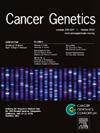51.微阵列在诊断 FISH 和核型正常的血液肿瘤中的作用
IF 1.4
4区 医学
Q4 GENETICS & HEREDITY
引用次数: 0
摘要
染色体分析和荧光原位杂交(FISH)检测是诊断、分类和评估骨髓增生异常综合征(MDS)、急性髓性白血病(AML)、B 细胞急性淋巴细胞白血病(B-ALL)和慢性淋巴细胞白血病(CLL)等血液肿瘤风险的标准技术。值得注意的是,至少有 10% 的 B-ALL、50% 的 MDS/AML 和 15% 的 CLL 病例的常规细胞遗传学检测结果是正常或无信息的,这阻碍了癌症基因组特征的准确描述。染色体微阵列分析(CMA)被广泛用于检测隐性染色体失衡和拷贝中性杂合性缺失,这超出了传统细胞遗传学方法的分辨率。本研究对已确诊为 B-ALL、MDS/AML 或 CLL,且 G 带核型和疾病相关 FISH 面板检测结果为阴性的患者的 CMA 实用性和诊断率进行了评估。在 5 年的时间里,共对 3628 份样本进行了核型、FISH 和 CMA 检测,其中包括 2720 例 MDS/AML、240 例 B-ALL 和 668 例 CLL。在诊断时,有 1466/2720 例 MDS/AML 患者(54%)、23/240 例 B-ALL 患者(9.6%)和 112/668 例 CLL 患者(16.8%)的核型和 FISH 报告正常。利用 CMA,在 14.6% 的 MDS/AML 病例、26.1% 的 B-ALL 和 6.3% 的 CLL 患者中发现了具有诊断和预后意义的亚显微拷贝数改变。此外,CMA 还发现了在分裂期细胞中未观察到的染色体大面积异常的克隆。在血液系统恶性肿瘤的诊断中使用 CMA 可显著提高诊断率,并为患者的特定风险分层、预后和治疗决策提供数据。本文章由计算机程序翻译,如有差异,请以英文原文为准。
51. Utility of microarray in the diagnosis of hematologic neoplasms with normal FISH and karyotype
Chromosome analysis and fluorescence in situ hybridization (FISH) testing are the standard techniques in diagnosis, classification, and risk assessment of hematologic neoplasms such as myelodysplastic syndrome (MDS), acute myelogenous leukemia (AML), B-cell acute lymphoblastic leukemia (B-ALL), and chronic lymphocytic leukemia (CLL). Notably, the result of conventional cytogenetic testing is normal or non-informative in at least 10% of B-ALL, 50% of MDS/AML, and 15% of CLL cases, preventing accurate characterization of cancer genomic profile. Chromosomal microarray analysis (CMA) is widely used for detection of cryptic chromosomal imbalances and copy-neutral loss of heterozygosity, which are beyond the resolution of conventional cytogenetic methodologies. This study has evaluated the CMA utility and diagnostic yield in patients with an established diagnosis of either B-ALL, MDS/AML, or CLL, and negative findings of G-banding karyotype and disease-relevant FISH panel testing. During a 5-year period, karyotype, FISH and CMA were performed on 3628 samples, including 2720 cases of MDS/AML, 240 B-ALL and 668 CLL cases. At diagnosis normal karyotype and FISH were reported for 1466/2720 (54%) of patients with MDS/AML, 23/240 (9.6%) of B-ALL, and 112/668 (16.8%) of CLL cases. Using CMA, submicroscopic copy number alterations of diagnostic and prognostic significance were identified in 14.6% of MDS/AML cases, 26.1% of B-ALL, and 6.3% of CLL patients. Additionally, CMA revealed clones with large chromosomal abnormalities that were not observed among metaphase cells. Implementation of CMA in diagnosis of hematologic malignancies can significantly improve the diagnostic yield and provide data for a patient-specific risk stratification, prognostication, and therapeutic decisions.
求助全文
通过发布文献求助,成功后即可免费获取论文全文。
去求助
来源期刊

Cancer Genetics
ONCOLOGY-GENETICS & HEREDITY
CiteScore
3.20
自引率
5.30%
发文量
167
审稿时长
27 days
期刊介绍:
The aim of Cancer Genetics is to publish high quality scientific papers on the cellular, genetic and molecular aspects of cancer, including cancer predisposition and clinical diagnostic applications. Specific areas of interest include descriptions of new chromosomal, molecular or epigenetic alterations in benign and malignant diseases; novel laboratory approaches for identification and characterization of chromosomal rearrangements or genomic alterations in cancer cells; correlation of genetic changes with pathology and clinical presentation; and the molecular genetics of cancer predisposition. To reach a basic science and clinical multidisciplinary audience, we welcome original full-length articles, reviews, meeting summaries, brief reports, and letters to the editor.
 求助内容:
求助内容: 应助结果提醒方式:
应助结果提醒方式:


